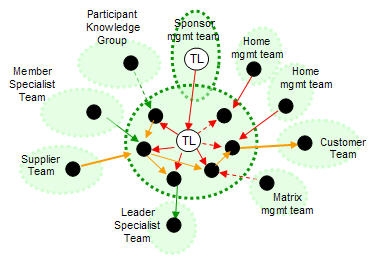Work Flows Inside and Between Teams
A team’s internal workflow is for naught if it is not delivered to an external customer, and, most likely, the team requires some external inputs for their work process and product. One or more team workflow roles, then, connect to external roles that themselves are highly likely to be parts of supplier-customer teams (even individual consumers are embedded in households). Team members may have a variety of reporting, leadership, and membership roles in external teams. All these external teams together represent the “1-degree” neighborhood of the reference team.
From the point of view one, particularly workflow, team this circle of relationships represents “local knowledge” held by the team itself in its multiplicity of roles. External team relationships may be expressed either by direct interaction with one person in a role, a team-level interaction that the external person is a member of or leads, or the organization that the person-role represents (e.g., a customer rep for a supplier organization).
No team is an island. Teams interrelate either or both by interlocking team members and interdependent inter-team roles. Each team lives most immediately in its local bubble of interrelated teams, a local ecology of suppliers and customers that defines work across a strategic purpose.
|
Team’s 1-Degree Circle of Relationships
|
 |
Local Knowledge |
| Teams are embedded in a larger network of teams that is connected directly (1° of separation) through one or more links with people-in-roles inside the team. A team’s one-degree neighborhood includes teams interlocked by common members and interrelated roles through flows between teams
As work has become more complex and members of teams more distributed, it becomes more necessary to make processes explicit. It doesn't require much: the basic relationships between team members and tasks are easily rendered at a high-level (e.g., the Relationship Matrix) which can then be explicated down to whatever level of detail is appropriate.
Being explicit is how a team captures its knowledge and improves it over time. If done as part of the work, and captured, for example, in a virtual team room, then the organization has a growing repository of tactical knowledge and teams have a way of improving its work process internally and externally, and of bringing new members into the team’s working network of roles.
|
|